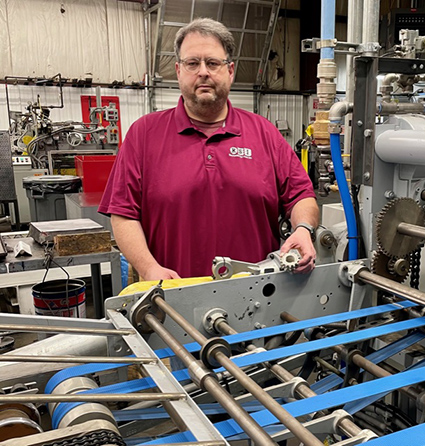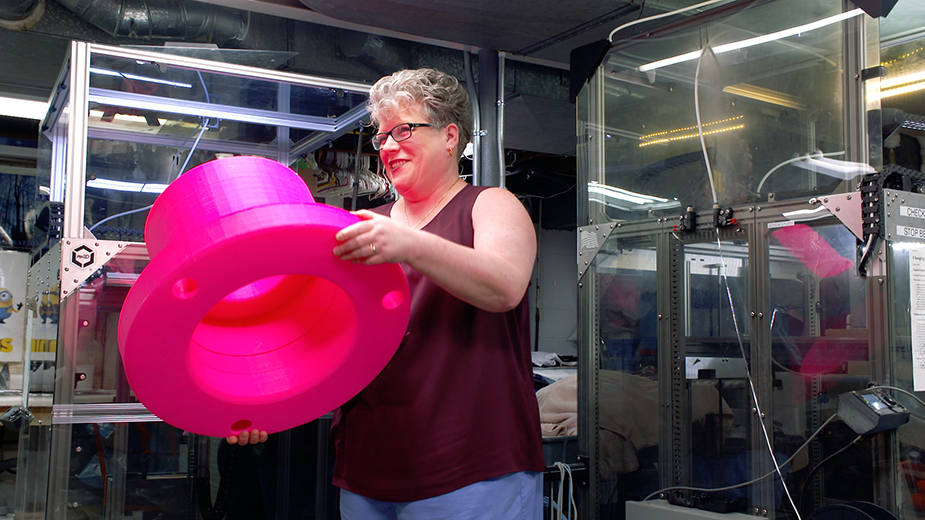YOUNGSTOWN – At first glance, conventional wisdom would suggest that Reynolds Services Inc. in Greenville, Pa., has little use for a 3D printing operation.
The core business of the company is traditional metal processing, such as cut-to-length capabilities, sheeting, coating, slitting and finishing. The bulk of these products is shipped to customers that manufacture containers for several market segments, mostly the food industry.
Additive manufacturing, or 3D printing, is most often associated with low-volume production and manufacturers that serve aerospace or military applications. But executives at RSI saw it differently: what if the company were to integrate 3D printing into its business as an additional service for its customers?
“We deal with a lot of manufacturers,” says Joe Vavro, director of business development at RSI. “And these manufacturers have a need for equipment and parts.” Aside from processing steel for these customers, the company thought it wise to develop an additive manufacturing division to produce replacement parts such as gears and other components that these customers require for their own machinery and equipment.
“It complements what we sell to them,” Vavro says.

Additive manufacturing is a process where a component is built autonomously from a digital design. Designs are electronically transmitted to 3D printers, which act similarly to inkjet printers in that a nozzle is used to dispense material such as polymer or even molten metal onto a flat surface. In essence, the printers read the digital design and build these parts from the ground up.
RSI’s opportunity to enter the business came in 2019, when it bought Meridian Arts & Graphics in Liberty Township, Ohio. That company used 3D printing to make prototypes of products that could display its graphic designs. At the time, Meridian used a single printer dedicated solely for plastics.
Since the acquisition, RSI has added four printers to its lineup and expanded its materials feedstock to include carbon fiber, stainless steel, copper and tool steel, Vavro says. “We saw the need to shift from doing customer prototype work to doing work for medium-size and light-manufacturing applications.”
Vavro says RSI would receive requests from manufacturers or machine shops that would need components made from materials such as carbon fiber. “We have a lot of customers who use older equipment,” he says. Often, it’s nearly impossible to find replacement parts for these machines. It’s unlikely that original drawings exist from which to manufacture new components. Even if it were possible to manufacture a new part, it might take weeks for it to be finished.
However, by reverse engineering a component such as a gear or a cog and creating a digital schematic, a 3D printer could build the product in a matter of hours, Vavro says. “It’s something that we see as valuable to the customers we work with,” he says. “If a gear breaks a tooth, for example, and you don’t have time to get a new part, we can print it.”
RSI’s 3D printing services produce mostly smaller components that suffer the most wear and tear after repeated use, Vavro says. “It’s still a new business segment for us.”
Still, it’s a business that’s growing and RSI seeks to fill a void in what Vavro says is an underserved market. “It’s a growth slot for Reynolds,” he says. “When you look at medium size to smaller companies, there’s a niche that is overlooked for this technology.”
While additive manufacturing is often associated with big defense contractors such as Lockheed Martin or Raytheon, small- and medium-sized manufacturers also have a need, Vavro says.
“There’s another segment that can benefit from additive manufacturing,” he says. “Being a smaller company ourselves, that’s our kind of focus. We see the need out there.”
The additive manufacturing market has also allowed some small tool and die shops in the area to carve out new business through providing components for 3D printers.
“We’re manufacturing the parts that go into the machines,” says Kyle Kiraly, controller for Kiraly Tool & Die, Youngstown. Nozzles, bracketing for rail systems inside the printer, metal frames – all are parts machined and produced at Kiraly. Among the company’s biggest customers is JuggerBot 3D, which manufactures 3D printers out of the Tech Block 5 Building at the Youngstown Business Incubator. “We’ve probably produced about 80% of the machined components for these printers.”
Steve Kiraly, its president, says his company also performs secondary machining operations on 3D-printed parts. “Sometimes there are certain tolerances they can’t get, so it has to be secondary machined,” he says. “It’s a small part of our business, but it’s noticeably expanding.”
Meanwhile, other companies engaged directly in additive manufacturing have experienced sizeable growth as industries adapt to this new technology.
“Our customer base has skyrocketed,” says Pamela Szmara, president of Pamton 3D Commercial Printing in Youngstown. The company is a contract 3D printer for companies across the country in the medical, dental, defense, aerospace, automotive and engineering fields. “I can’t begin to describe it,” she says.
Szmara says her company – now about five years old – is doing both large and small production runs of finished components as well as prototypes. However, she says she’s limited as to what she can talk about since the company has signed several nondisclosure agreements. Pamton 3D works closely with America Makes and some ongoing projects there, while it recently began to print resin crowns for the dental industry.
“We started that about a month and a half ago. It’s brand new on the market,” she says. “We’re still kind of working out some of the glitches – working closely with a lot of the engineers and dentists.”
Szmara says it’s likely to take some time before these reach the production phase and are introduced on a national scale, which is not unusual when new materials or products are developed for the dental market. “We’re working on different scanning capabilities, more shades for tooth color. There’s been a lot going on,” she says.
Pamton 3D has made products such as personal protective equipment through the pandemic, holding brackets used for tractor trailers that ship automotive parts, large-volume aquarium pumps and during the holidays, even a giant green head of the Grinch. “We wanted a little bit of laughter because it’s been such a stressful year,” she says of the Grinch project.
Recently, the company finished a weight and balance tool project through America Makes with the Army and is awaiting new bids for future work, Szmara says.
Pamton 3D owns 10 printers and is able to print in all-plastic, carbon fiber, stainless steel, ceramic and other materials, Szmara says. The possibilities for this technology are endless, she says, especially in the Mahoning Valley. “The sky’s the limit,” she says. “The markets in the future will continue to be automotive and the armed services,” she says. New ventures such as Lordstown Motors and Ultium Cells also present great opportunities to advance this technology on a local level.
Still, keeping abreast of new developments across the industry and remaining competitive requires patience.
“It is constantly changing every day,” Szmara says. “With new materials, new processes, but we’re not able to achieve all of this without trial, error and a lot of mistakes. You have to be willing to go through the growing pains.”
Pictured at top: Pam Szmara, president of Pamton 3D Commercial Printing, removes a printed part from one of the company’s 10 machines.
